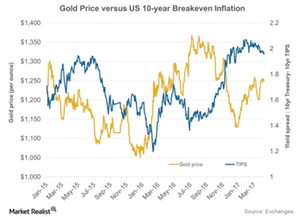How Inflation Becomes a Core Determinant of the Price of Gold
The possible interest rate hike is taking a lot of market participants’ attention. Many policymakers are also focusing on inflation numbers.
Nov. 29 2017, Updated 12:00 p.m. ET

Gold as a hedge
The possible interest rate hike is taking a lot of market participants’ attention. Many policymakers are also focusing on inflation numbers. Fed chair Janet Yellen said the Fed is reasonably close to its goal and should maintain a rather gradual pace of rate hike so inflation meets its target.
Gold and inflation have a famous relationship, and gold is traditionally used as a hedge against inflation.
Inflation reading
To depict inflation in the above chart, we’ve used the yield spread or break-even spread. It measures the difference between the ten-year US government bond yield and Treasury Inflation-Protected Securities (or TIPS).
The principal invested in TIPS is adjusted according to the CPI (consumer price index). The yield spread, therefore, seems to be a good proxy for the US inflation measure. Inflation in the United States will be largely dependent on economic numbers.
Unemployment claims
Among the top-watched numbers last week were unemployment claims, which stood at 239,000. The market forecast 241,000. These claims measure the number of individuals who filed for unemployment for the first time during the past week. The lower the number, the better it is for the economy.
Mining shares that joined gold and silver in the price slump include Yamana Gold (AUY), Kinross Gold (KGC), Iamgold (IAG), and Harmony Gold (HMY). These four miners fell 1.5%, 2.3%, 1.3%, and 1.1%, respectively. The famous gold and silver-based funds, the Merk Gold ETF (OUNZ) and the iShares Silver Trust (SLV), have risen 1.4% and 1.8%, respectively, on a 30-day trailing basis.
